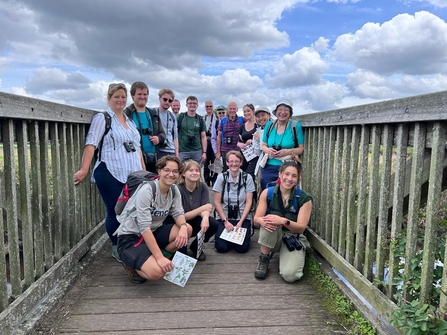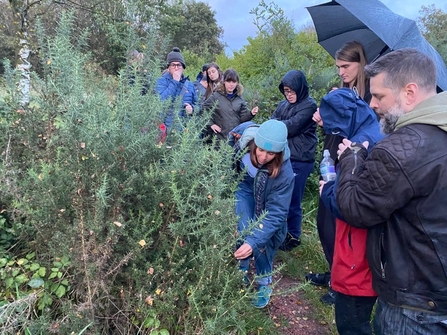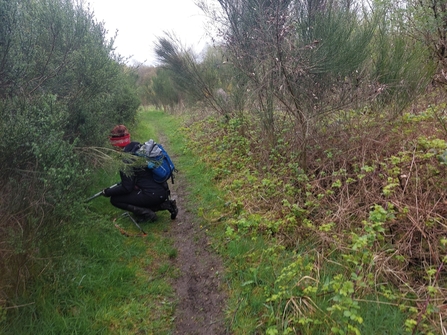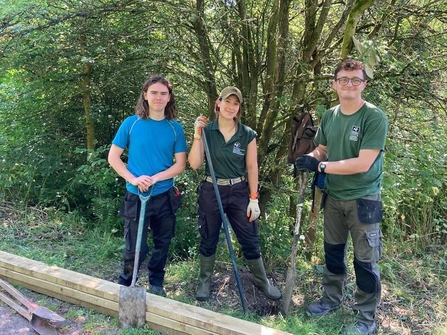A year ago, I had no idea Wigan existed, let alone that it was a wildlife haven. As a naïve young woman from the Southwest coast, the North to me was classed as anything past Bristol. It was a place I didn’t have the opportunity to travel to growing up, so the idea of moving to the dramatic landscape of the North was enigmatic, daunting, and exciting. As a recent graduate ecologist, I was desperate for a job in the conservation sector, and I was willing to move anywhere for it. But I wasn’t expecting Wigan.
Moving to the Wild Wigan
By Tony Da Silva

Making new friends in a new place via the power of volunteering. Photo by Hannah Westhenry
When I got the phone call from Wigan Legend, Dr Mark Champion, that I had got the role of LWT’s Wigan Reserve Assistant Ranger, I didn’t quite know what to do with myself. After a fair few job rejections at this point, I thought it would be another. I spent the rest of the day in a weird daze, getting my head round the fact that I would be moving North. Searching Wigan in Google, the first thing that came up was ‘Friendliest town in England’. That didn’t sound too bad.
Good ol’Google was right. On-site visitors stop to chat, telling us what wildlife they’d seen, asking what we were up to, all the while a dog gets patted. Out and about, buying eggs can turn into a half day outing, everyone has the time to talk. Train and bus journeys go faster when you have a story to hear and one to tell. After getting my ear in on the accent and learning the slang (like eating ‘babiesYed’- which is nothing to do with consuming babies…) and befriending some very lovely locals, in a short time I felt at home in Wigan.

Volunteers in wet Wigan
But that wasn’t the case straight away. When I first travelled up to find somewhere to live, I took a quick visit to Wigan Flashes to see where I’d be working for the next year. A bleak, cold, grey Monday in March didn’t shine the site in the best light. I wasn’t used to seeing rising brick red factory buildings from a reserve or hearing constant traffic with intermittent sirens, accompanied by some questionable smells... The post-industrial landscape was a whole new world to me as a sheltered country southerner.
But the more I learnt, the more I saw the hidden green gems in Wigan, the more I understood that these nature reserves were like nowhere else in the UK. Subsided mines across Wigan and Leigh that filled with water, left for primary succession to take place, had become the ideal habitat for birds, mammals, insects, and plants- common to rare. Flittering willow tits, cryptic booming bittern, marsh southern orchids and much more, made the Flashes of Wigan and Leigh their home. Nature taking back what was theirs.

Forging new paths. Photo by Hannah Westhenry
Fens, woodland, meadows, mosses and flashes- all contribute to Wigan’s diverse mosaic of habitats. In spring, the meadows become something out of ‘The Sound of Music’. As if Julie Andrews should come bursting out a recently treated invasive American Dogwood patch and frolic through blooming wildflowers, framed beautifully by conifers and deciduous trees. But preserving these habitats doesn’t come without its challenges. Lack of knowledge and connection to these reserves often leads to their abuse, experiencing their fair share of off-road vehicles, vandalism, and illegal activities, that the Wigan Team must attend to. It’s where conservation efforts are needed most.

Hannah with colleagues Mark Forristal (left) and Matt Freeman (right)
"Now, as one of the only urban National Nature Reserves in the UK, the beauty of Wigan and Leigh is getting the attention it deserves. Soon, even southern lasses like me will be able to pinpoint Wigan on the map, with some idea of the natural beauty and iconic history that it holds."
-Hannah Westhenry, Wigan Reserve Assistant Ranger

